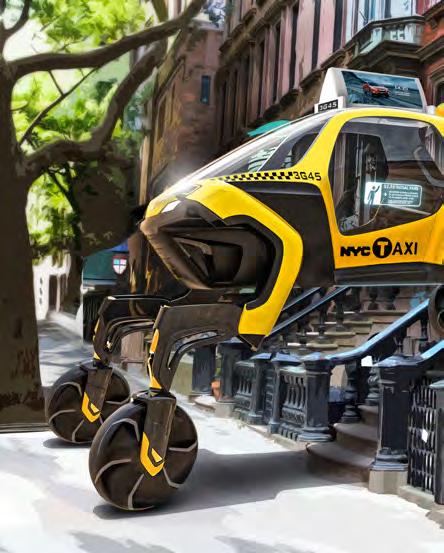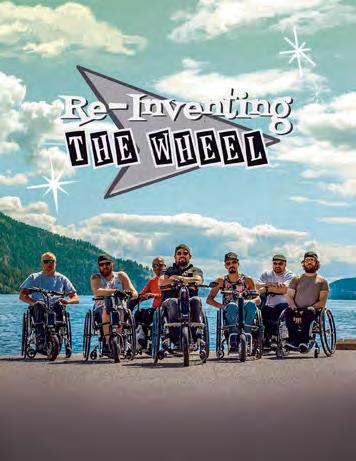
4 minute read
POSTS
Run to Hulu
What better way could there be to spend Mother’s Day than in a movie theater watching a thriller about a creepy mom who has kept her wheelchair-using daughter completely isolated from the world and controlled her every move? Prior to the pandemic, that was the thinking that led Hollywood to schedule Run for a May 8 release to coincide with Mother’s Day weekend. Now, six months later, you can finally see whether the film’s buzz was deserved.
Advertisement
Photo by Allen Fraser/Lionsgate Real-life wheelchair-using actor Kiera Allen takes direction from Aneesh Chaganty.
The film stars Emmy and Golden Globe winner Sarah Paulson (American Horror Story, The People vs. O.J. Simpson) as the mom and newcomer Kiera Allen — a real wheelchair user — as the daughter, and finally gets its worldwide debut Nov. 20 on Hulu. Disability writer Emily Ladau says not to miss Allen’s breakthrough performance. “To know that Kiera Allen wasn’t performing disability, but rather that she was performing a character, made it feel as though watching Run was a radical act,” says Ladau. “There’s power in witnessing authentic disability representation on screen.” Make sure to visit Newmobility.com in the days leading up to the release for Ladau’s interview with Allen. Ph ot o b y Al l e n Fraser / L ionsg ate 8 NEW MOBILITY A New Way to Stand


It seems like there’s a new prototype wheelchair popping up every few weeks, and the latest to generate online discussion is the modified Segway stander built by United Kingdom architect Suzanne Brewer. Brewer, who does not use a wheelchair, has been working on the prototype for two years.
“Standing wheelchairs at the moment are bespoke, they are made for that person,” Brewer told Architects’ Journal. “That Suzanne Brewer and her nondisabled son Jarvis demonstrate doesn’t make her Segway-based stander. them accessible to enough people, unfortunately, and it makes them very expensive.” Most run around £25,000 in the U.K., which spurred Brewer to create a generic model that is more affordable and usable by most anyone who needs it. Check out bit.ly/2SG3GZs to see what you think.

Forget wheels and ramps — maybe the accessible transportation solution we’ve all been waiting for is … a car with robotic legs? As crazy as that may sound, this September Hyundai announced it is pursuing that technology in a line of new Ultimate Mobility Vehicles:
A car with robotic legs could save lives as the first responder in natural disasters; or, people who do not have access to an ADA ramp could hail a car to walk up to their front door, level itself, and allow wheelchairs to roll right in.
To read more about Hyundai’s vision, and to see more renderings, visit hyundainews.com/en-us/releases/3152.

Disabled Voting Bloc Grows
A September study confirmed that people with disabilities form an increasingly large, powerful and potentially decisive percentage of the electorate. The report by the Program for Disability Research at Rutgers University projected that 38.3 million eligible voters have a disability — a 19.8% jump since 2008 — and more than 25% of the American electorate may be motivated by issues affecting the disability community.
“The sheer size of the disability electorate makes it clear that people with disabilities and their family members have the potential to swing elections,” said Lisa Schur, director of the Program for Disability Research at Rutgers University. “While their partisan split is similar to that of other citizens, people with disabilities put a higher priority on health care and employment issues, so how candidates deal with those could be decisive.” • At 38.3 million people, the number of disabled people who will be eligible to vote in the November 2020 elections exceeds the number of eligible voters who are Black (29.9 million) or Hispanic (31.3 million). • The study projected 21.3 million eligible voters with a mobility disability.
For the full report, visit tinyurl.com/y5qlbxqf.
Wheelchairs for Cows?
Ruby Sue just wanted to run and play like all the other calves, but thanks to “curly calf syndrome” her back half was paralyzed. Committed to leaving no calf behind, New Hampshire-based Walkin’ Pets designed and built a custom wheelstand to allow Ruby Sue to live an active life. Find out more about Walkin’ Pets on Facebook: facebook.com/HandicappedPets.

THE NEW DOCUMENTARY RE-INVENTING THE WHEEL FOLLOWS A PEER SUPPORT GROUP OF ACTIVE WHEELCHAIR USERS IN CANADA’S OKANAGAN VALLEY AND ITS EFFORTS TO HELP ONE MAN ADJUST TO HIS FIRST YEAR AFTER SCI. THE FILM DEBUTED IN SEPTEMBER AT THE LUNENBURG DOC FEST IN CANADA. FOLLOW THE FILM’S FACEBOOK PAGE FOR INFO ON WHERE TO WATCH: FACEBOOK. COM/REINVENTINGTHEWHEELMOVIE.

Stick-to-It with CatTongue Grip Tape
Anyone reading this knows how annoying it is to have a cell phone or tablet constantly slip off your lap. CatTongue Grips makes one of the grippiest adhesive pads we’ve ever had the opportunity to try, and last fall the company launched a new product that should be even more helpful for those with limited grip strength. Its non-abrasive grip tape is made out of the same waterproof, dishwasher safe material as its phone pads, but comes in roll form so you can cut and stick it onto your footplate, workout equipment, favorite water bottle, tools, handcycle pedals, and pretty much wherever you could use a little extra friction.
Grip Tape is available for $19.99 and cell phone pads are $12.99 from cattonguegrips.com.










